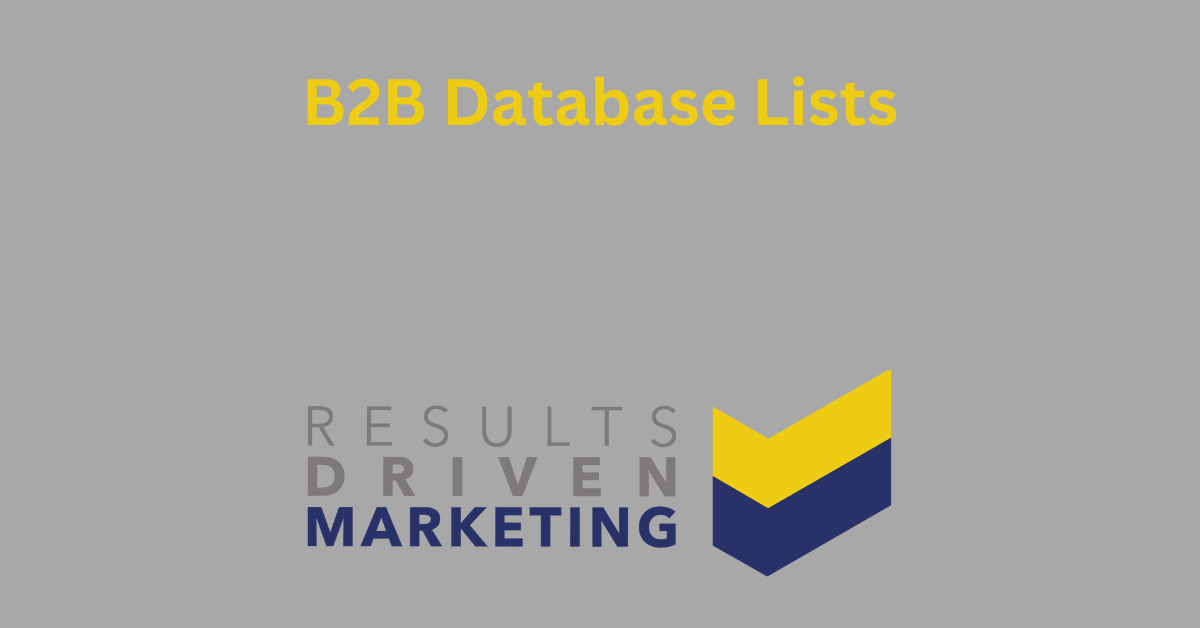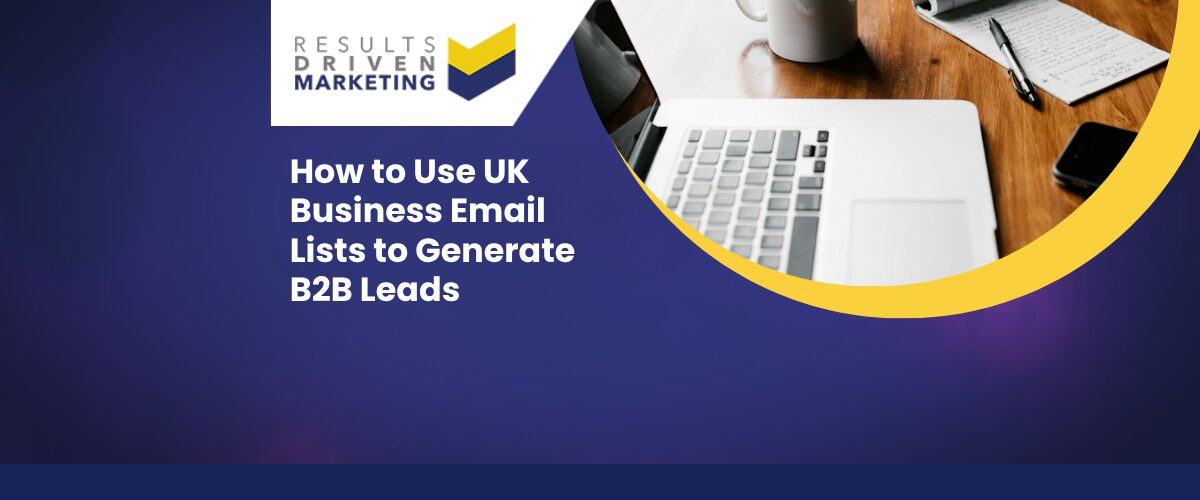
B2B Database Lists
B2B Database Lists are a collection of contact information – email addresses and other relevant information – of businesses and/or individuals who may potentially be interested in a company’s products or services.
B2B Database Lists can be used for campaigns to generate leads, customer communications, sales distribution and more.
What are B2B Database Lists used for?
Business mailing lists are used for direct mail campaigns, promotional mailings, and targeted marketing.
These lists are typically compiled from different sources to create an up-to-date list of customers, prospects, and subscribers.
Business mailing lists are often used to send newsletters, product updates, special offers, and other related communications.
Why are they so important?
B2B Database Lists are important because they provide a way to quickly target potential customers with specific messages that are likely to be of interest to them.
B2B Contact Lists allow businesses to quickly and easily target a specific and relevant audience to ensure higher conversion rates and increased engagement.
These lists can be easily customised to the target market and are the most cost-effective means of marketing.
Additionally, with business mailing lists, companies can reach a larger and more engaged customer base, help to build relationships with customers, generate leads, and create brand awareness.
What are the main benefits of using B2B Database Lists?
Access to Highly Targeted Contact Information
Business mailing lists can help businesses segment target audiences quickly and accurately.
This helps ensure that the right people and companies get the right messages.
Low Cost Marketing
Bulk mailing lists are one of the most cost effective marketing tools available to businesses.
By having access to an accurate and up-to-date list of contacts, companies can save time, money, and resources.
Increased Brand Recognition
Sending direct mailers to targeted audiences can help build brand recognition.
Brand messaging can be easier to understand through direct mail and help create recognition among potential customers.
Increased Connections with Potential Customers
Business mailing lists can help companies make connections with potential clients.
By connecting with the right people, businesses can create meaningful relationships with their target audiences.
Opportunity to Increase Sales
With the right mailing list, businesses can increase sales opportunities.
By targeting the right people, businesses can identify potential customers and create a tailored marketing message to reach them.
Improved Quality of Leads
Quality leads create better sales.
By utilising mailing lists, businesses can access information to segment the right contacts and create highly targeted campaigns.
This will help ensure that the leads generated are of high quality.
What are the different types of B2B Database Lists available?
Industry Specific Business Lists
These lists include detailed information on businesses within a specific industry, including information on location, size and contact details.
Targeted Business Lists
These lists focus on specific criteria, such as geography, demographics, and size, so that you can focus on the customers that you’re interested in marketing to.
Executive Lists
These are high-end business lists focused on C-level executives and senior decision makers within an organisation.
Compiled Business Lists
These are lists compiled from publicly available sources that offer basic contact information, such as name and email address.
Specialty Business Lists
These lists are tailored to include businesses that fit within the parameters of the particular industry you’re interested in.
How to build a list of B2B Contact Lists?
Use opt-in forms on your website or landing pages
Include an opt-in box on company invoices or receipts
Collect email addresses at trade shows, conferences, or other events
Leverage social media
Utilise any partnerships or connections you have
Offer incentives for signing up
Buying a third-party list
There is so much to cover that I won’t go into full detail now, but I will cover the absolute basics.
Make sure you have a clear data brief
It is essential to understand exactly who your target audience is and to develop an ICP.
You can do this on your own but may want to consider working alongside a supplier like Results Driven Marketing at this point to help you ask the questions of your customer database that you need to.
These questions might be along the lines of:
Where are your top customers located geographically?
What sectors do they operate in?
How many staff do they have?
How much do they turnover?
Who within those organisations do you look to target?
Make sure your potential supplier provides you with samples and breakdowns
Getting this information is really important to make sure that your supplier fully understands your brief and is aware of exactly what your ICP is.
At Results Driven Marketing, we supply both breakdowns and then samples.
This makes sure clients are comfortable that we clearly understand and will be delivering a database that will work for you.
Check the licensing terms
Post-GDPR, most suppliers offer licensed products. The most common is a 12-month multi-use licence.
This might sound like you can use it as much as you like over a 12-month period but may actually be limited to 12 email sends only.
We find that 12 emails sends over a 12-month period are adequate, but it is important that you understand all the usage rules before you dive in.
Check supplier accuracy guarantees
Is the supplier’s database guaranteed accurate? What if you get it and all the emails bounce?
Ask your supplier what guarantees they have in place should things not work out as you would expect.
All files released by us are guaranteed accurate to industry high standards and are GDPR compliant.
We guarantee:
- 98% postal address accuracy
- 90% telephone number and contact name accuracy
- 90% email address accuracy
Should we fall below and of the above benchmarks, we are obliged to provide like-for-like replacements or a pro-rata refund.
Visit us here for more information.
How to segment B2B Database Lists?
Collect and analyse customer data
Create customer segments
Identify your target audience
Create targeted campaigns
How to maintain B2B Database Lists?
Keep it Up-to-Date
Make sure your business mailing list is always up-to-date.
Regularly review and delete outdated email addresses, add new contacts, and update missing or incorrect customer information.
Reach Out Regularly
Make sure to reach out to your contacts regularly with professional messages and offers.
If you’re not contacting your list regularly, you’re likely not getting the return you’d expect.
Segment Contacts
Segment your contacts into different lists so you can better target your messages.
You can also create custom audiences based on customer behaviours, interests, or demographics.
Utilise Automation
Use automated processes and triggered emails to simplify the process of engaging contacts.
You can use automation to save time and ensure that no customer goes unnoticed.
Analyse Your Data
Use analytics to get valuable insights from your business mailing list.
Analyse your contact data to measure the success of your campaigns, uncover trends and opportunities, and understand your customers better.
How to cleanse your list?
Best practices for email marketing to B2B Database Lists
Make sure your email copy is succinct, relevant and engaging
Utilise personalisation
You can use customer or demographic data to tailor emails to relevant subscribers.
Leverage segmentation
You should segment your database into different categories and target each group with emails that are tailored to their interests.
Include a call to action
Let subscribers know what you want them to do in order to take the next step.
Utilise A/B testing
Experiment with different variables in your emails to maximise their performance.
Monitor your metrics
Track various metrics from your emails (such as open rate, click-through rate, and conversion rate) to make sure your messages are effective.
How to A/B split test email marketing campaigns to b2b database lists?
A/B split testing is a crucial tool for businesses when it comes to email marketing campaigns.
It helps determine if one approach is more effective than another when it comes to reaching their customer base.
A/B testing can be used to analyse a number of variables to help optimise the performance of an email marketing campaign, such as subject lines, call to action phrases, image layouts, and more.
When it comes to A/B split testing email marketing campaigns to B2B contact lists, the process starts with selecting two versions of the same email.
One email should have the control or “A” version, and another should have the option or “B” version. It is important to consider the audience when choosing which methodologies and approaches you plan to experiment with.
For example, if the audience is retailers, a different approach may be used than with a corporate audience.
Once the two emails have been selected, the campaigns are distributed to the preferred B2B contact lists.
It is important that the lists have previously opted in to receive emails from your business, as this will keep your email marketing campaign from appearing as spam.
After that, the two versions of the email should be tracked and monitored in order to analyse which version garners better results.
A/B split testing can be used to compare metrics such as open rate, click-through rate, unsubscribe rate, and more.
Finally
Finally, once the results of the split test have been analysed, the variations with the most successful metrics should be implemented.
Undoubtedly, the house version should always be used and kept in rotation, as it will still contain important information and updates.
Regular split testing should be done in order to keep performance high and to continue to optimise the success of the email marketing campaigns.
A/B split testing is an essential component of running an effective email marketing campaign.
All B2B businesses, regardless of size and audience, can benefit from A/B testing to see which approaches lead to the best results.
Best practices for telemarketing to B2B Database Lists
Do your research
Develop a comprehensive understanding of the industry, target market, and product to ensure that your marketing messages are targeted and meaningful.
Personalise the message
Use targeted data to create personalised messages that resonate with the recipient.
Track results
Measure the response rate of your calls to determine which methods are most successful.
This is especially important if segmenting by type of business, location, etc.
Invite responses
Make sure your message includes a call to action, such as scheduling a meeting or requesting additional information.
Follow up
Follow up calls with emails or additional calls if the prospect did not return your original call.
Limit the number of “no-answer” calls
Make sure that you do not overwhelm the recipient by making too many calls without getting any response.
Keep records
Keep detailed notes and create lists of calls that went well, hot leads and any feedback from prospects.
This will help you to refine and tailor future calls.
Adapt and evolve
Constantly review and analyse your results to see which methods are most successful and adjust your approach accordingly.
Best practice for direct mail to B2B Database Lists
Identify Your Target Audience
Before you begin your direct mail campaign, identify who your target audience is and ensure your mailing list is accurate and up to date.
Strategically Design Your Mail Piece
Make sure your mail piece is well-designed and professional in order to stand out from other mailings, and complements your brand.
Utilise Variable Data Printing
Take your direct mail to the next level by utilising variable data printing to personalise mail pieces for each recipient.
This strategy modernises traditional direct mail with relevant content tailored to the individual recipient.
Include a Call-to-Action
Don’t forget to include a call-to-action in your direct mail piece in order to maximise the effectiveness of your campaign.
Track, Measure, and Analyse Results
Measure and track ROI, response rate, and conversions in order to determine the success of your direct mail campaign.
Follow Up
After a direct mail campaign, following up is an essential step to maintaining relationships with potential customers.
Go the extra mile and send thank you emails or cards with special discounts and offers.
Summary
The use of b2b database lists has seen a dramatic increase as companies look for new methods to reach potential customers.
These b2b database lists are lists of names and contact information for people or companies that may be interested in a certain product or service.
The purpose of this list is for businesses to be able to contact their target audience and make their marketing campaign more targeted and effective.
Mailing lists can be segmented into various categories based on different demographics, such as age, gender, occupation, location, income, and interests.
Businesses may also use primary and secondary research to create more precise, targeted mailing lists.
When choosing a b2b contact list, marketers should consider the list’s relevancy, accuracy, and freshness.
Relevancy is determined by how closely the list matches the product or service being marketed.
Accuracy is important because if the list contains incorrect or outdated information, a business’s marketing efforts will be in vain.
Lastly, freshness is important because outdated information may be less accurate and lead to fewer conversions.
Businesses can also use a combination of email, direct mail, and telemarketing to reach their target audience.
Although these channels may be more expensive than simply using mailing lists, they have the potential to reach larger and more targeted audiences.
Additionally, businesses may need to combine these methods to maximise their reach and obtain better results.
Overall, business mailing lists can be a powerful tool for businesses looking to target their desired audience.
By utilising mailing lists, businesses can rest assured that their marketing efforts are more focused, accurate, and effective.
For more information about Results Driven Marketing and our third party mailing lists, feel free to contact us here.





